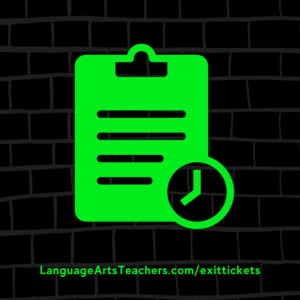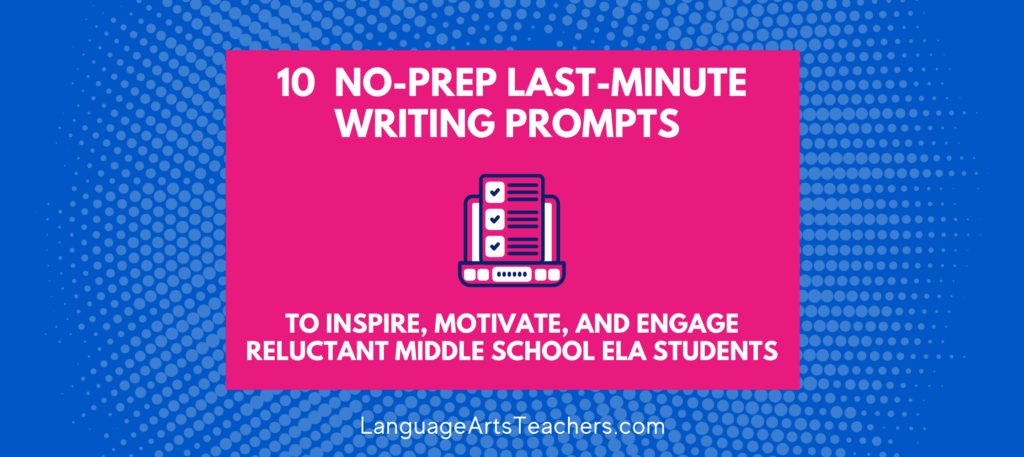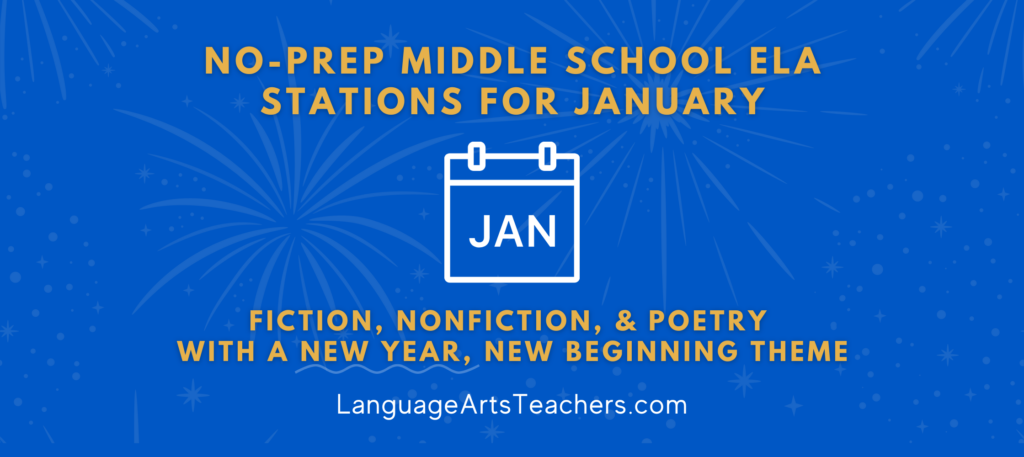Questions about Exit Tickets pop up quite often from teachers I work with in the Middle School ELA Teachers Lesson Plan Membership community, so the purpose of this post is to gather together some helpful tips, specific examples, and memorable strategies for Exit Tickets so you can use them better and easier in your own classroom starting ASAP 🙂

- Purpose: Increase student communication via Exit Tickets
Tip: Allow students to show what they know on an exit ticket in bullet format, drawing, paragraph, graphic organizer style, or other method.
Example: If you provide an exit ticket with one question on it during the last 5 – 10 minutes of class, allow students to respond in a way that makes sense for them. If the purpose is to increase communication with you by showing what they know, then some will respond in a full paragraph while others jot down a bulleted list of take-aways or a-ha moments. Still others may choose to craft a quick graphic organizer on the exit ticket and then fill it in. This has happened time and again in my own classroom where my Exit Ticket question involved a comparison and some students chose to sketch out a quick Venn Diagram, fill it in, and boom–done.
Strategy: Visually, it’s easy for me to assess at a glance and for students, it allowed them to focus more on showing me what they got from the lesson that day rather than focusing on “one more thing to do” before the bell rings.
- Purpose: Provide quick ways to differentiate using Exit Tickets
Tip: Ask three questions (comprehension, application, analysis or synthesis)
Example: I had just finished teaching a poetry analysis lesson with my students where I taught them the DIDLS strategy (Diction, Imagery, Details, Language, Syntax) and we talked about how to annotate as a way to make sense of a rather intense poem.
At the end of class, I wanted to know what they got from the day. I presented these three questions, but I didn’t assign ALL three to ALL students. Each student only got ONE of the three questions (more on that in a sec, but here are the three questions):
How does the DIDLS strategy help you understand what’s happening in a poem?
Compare the DIDLS strategy to “regular” poetry annotations you’ve learned about before.
List two things you learned today about DIDLS, and one question you still have.
Strategy: In one class, I presented all three questions to my students and told them to choose any ONE to respond to for their Exit Ticket. It was fascinating to see who chose which question (most chose the third one) and which one was chosen least or not at all.
*Note: If you do this and realize that one question was never chosen, then that’s something really interesting to dig into with your students. Did they not understand the question? Was it poorly written — hey, we’re not perfect LOL! Did it require too lengthy of a response and perhaps not enough time to think and write about it before the bell? It’s super interesting to get into the heads of your students with things like this–such insight in there!
In another class–my co-teaching class–I had those same three questions printed on a sheet of paper and the co-teacher and I quickly cut them apart so we could assign specific questions to specific students.
This allowed us to strategically meet students where they were by avoiding a situation where some students were at a more comprehensive level of understanding while others were ready for a larger challenge.
In that class, because we had students working at different levels, we wanted to stretch our students and learn about the lesson from their perspectives–but without risking a student trying to answer a question that they weren’t prepared to answer.
One more thing: You’ll find several simple, no-prep ways to engage students when reading poetry in class by clicking here (Hint: #4 is my favorite strategy and I use it the most often, usually at my students’ request!)
- Purpose: Anonymous fun with an Exit Ticket “snowball” fight
Tip: This is especially effective when you’re getting ready to read a novel and you want to ask a question that deals with a text-to-self connection in preparation of a discussion about a particular theme students will encounter in the novel.
Example: We were about to start reading Bud, Not Buddy by Christopher Paul Curtis (even my most reluctant and / or struggling readers consistently loooooove this one!). I wanted to facilitate a discussion the next day about one of the themes in the book → Family relationships.
My question for the exit ticket the day prior was “Who is your family, and what does ‘family’ mean to you?”
Since that could be considered a personal, sensitive topic for middle school students, I told them their answers would be completely anonymous–no names!
. . . And to lighten the potentially heavy emotional load, I told them we would have a “snowball fight” once everyone had finished their responses (more on that in a minute).
Strategy: I gave each student a pre-printed Exit Ticket on a sheet of paper (IO wanted all the papers to look and feel the same, and I used one sheet per student so it would be large enough to crumple up and throw).
Each student also had an ordinary blue pen I provided in the name of safe anonymity so they could respond to the question. They knew the Exit Ticket question had to do with something we were about to start reading (they didn’t know which novel, specifically >> Click Here << to read all about my “20 Questions” game I use to ramp up excitement for ANY novel (kids literally BEG to start reading it because of that game).
Anyway. Back to the Exit Ticket “snowball fight” (wink).
Students write their answers and wait quietly until the timer goes off (I set it for 3 minutes while music is playing).
When time’s up, everyone crumples their paper and throws it across the room! The rule is that it is picked up and thrown 2 – 3 more times before going into the basket I have. We don’t read them until the next day at the very beginning of class.
To support the anonymity aspect of this Exit Ticket, I keep one huge basket with ALL my classes’ “snowballs” and so the next day, we read through them together, just grabbing a few from all the classes mixed together. We read, share, discuss, and get a heartfelt sense of the question which guides discussion, promotes empathy, and readies us all for the content inside the novel.
Looking for a full, 100% done-for-you curriculum with naturally-embedded strategies like these for all things reading, writing, speaking, and listening?
Join hundreds of us from around the country in the Middle School ELA Teachers Lesson Plan Membership so you can jump off the struggle bus 🚌and find confidence, clarity, and creativity again in teaching!




